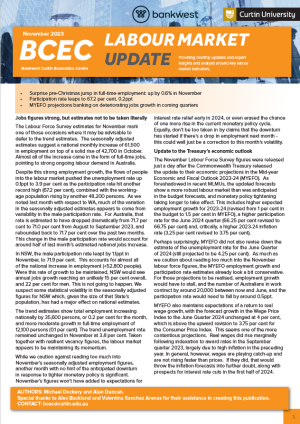BCEC Monthly Labour Market Update – November 2023
– Surprise pre-Christmas jump in full-time employment: up by 0.6% in November –
– Participation rate leaps to 67.2 per cent, 0.2ppt –
– MYEFO projections banking on deteriorating jobs growth in coming quarters –
Jobs figures strong, but estimates not to be taken literally
The Labour Force Survey estimates for November mark one of those occasions where it may be advisable to defer to the trend estimates. The seasonally adjusted estimates suggest a national monthly increase of 61,500 in employment on top of a solid rise of 42,700 in October.
Almost all of the increase came in the form of full-time jobs, pointing to strong ongoing labour demand in Australia. Despite this strong employment growth, the flows of people into the labour market pushed the unemployment rate up 0.1ppt to 3.9 per cent as the participation rate hit another record high (67.2 per cent), combined with the working age population rising by another 48,200 persons. As we noted last month with respect to WA, much of the variation in the seasonally adjusted estimates appears to come from variability in the male participation rate. For Australia, that rate is estimated to have dropped dramatically from 71.7 per cent to 71.0 per cent from August to September 2023, and rebounded back to 71.7 per cent over the past two months. This change in the male participation rate would account for around half of last month’s estimated national jobs increase.
In NSW, the male participation rate leapt by 1.1ppt in November, to 71.9 per cent. This accounts for almost all of the national increase in employment (+52,800 people). Were this rate of growth to be maintained, NSW would see annual jobs growth reaching an unlikely 15 per cent overall, and 22 per cent for men. This is not going to happen. We suspect some statistical volatility in the seasonally adjusted figures for NSW which, given the size of that State’s population, has had a major effect on national estimates.
The trend estimates show total employment increasing nationally by 35,600 persons, or 0.2 per cent for the month, and more moderate growth in full-time employment of 12,100 persons (0.1 per cent). The trend unemployment rate remained unchanged in November at 3.8 per cent. Taken together with resilient vacancy figures, the labour market appears to be maintaining its momentum.
While we caution against reading too much into November’s seasonally adjusted employment figures, another month with no hint of the anticipated downturn in response to tighter monetary policy is significant. November’s figures won’t have added to expectations for rate relief early in 2024, or even erased the chance of one more rise in the current monetary policy cycle. Equally, don’t be too taken in by claims that the downturn has started if there’s a drop in employment next month – this could well just be a correction to this month’s volatility.
Update to the Treasury’s economic outlook
The November Labour Force Survey figures were released just a day after the Commonwealth Treasury released the update to their economic projections in the Mid-year Economic and Fiscal Outlook 2023-24 (MYEFO). As foreshadowed in recent MLMUs, the updated forecasts show a more robust labour market than was anticipated in the budget forecasts, and monetary policy tightening taking longer to take effect. This includes higher expected employment growth for 2023-24 (revised from 1 per cent in the budget to 1.5 per cent in MYEFO), a higher participation rate for the June 2024 quarter (66.25 per cent revised to 66.75 per cent) and, critically, a higher 2023-24 inflation rate (3.25 per cent revised to 3.75 per cent).
Perhaps surprisingly, MYEFO did not also revise down the estimate of the unemployment rate for the June Quarter of 2024 (still projected to be 4.25 per cent). As much as we caution about reading too much into the November labour force figures, the MYEFO employment growth and participation rate estimates already look a bit conservative. For those projections to be realised, employment growth would have to stall, and the number of Australians in work contract by around 20,000 between now and June, and the participation rate would need to fall by around 0.5ppt.
MYEFO also maintains expectations of a return to real wage growth, with the forecast growth in the Wage Price Index to the June Quarter 2024 unchanged at 4 per cent, which is above the upward revision to 3.75 per cent for the Consumer Price Index. This seems one of the more contentious projections. Real wages did rise marginally following indexation to award rates in the September quarter 2023, largely due to high inflation in the preceding year. In general, however, wages are playing catch-up and are not rising faster than prices. If they did, that would throw the inflation forecasts into further doubt, along with prospects for interest rate cuts in the first half of 2024.




